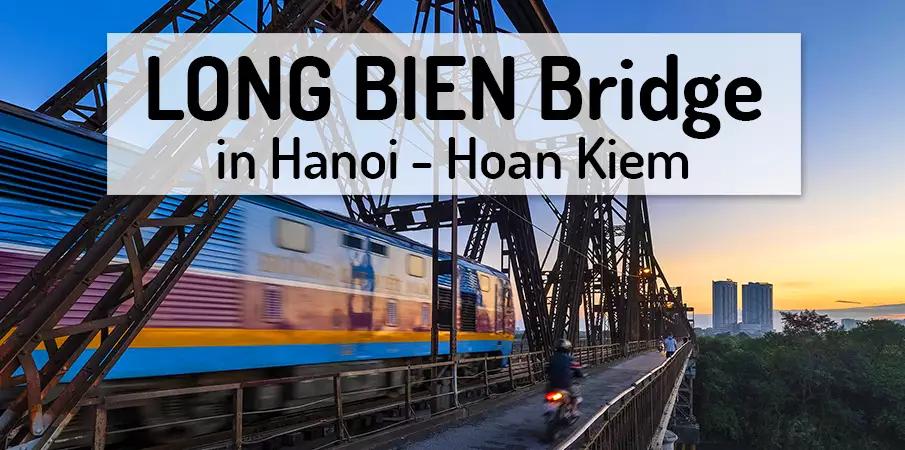
Quick answer: Long Bien Bridge is a historic steel bridge over Hanoi’s Red River, built by the French between 1899–1902. It’s a symbol of resilience—surviving wars, bombings, and decades of use—and today it’s a beloved landmark where locals walk, catch sunset views, or ride motorbikes.
At a glance:
- 📍 Location: Connects Hoàn Kiếm District to Long Biên District across the Red River.
- ⏱️ Built: 1899–1902 by French firm Daydé & Pillé, originally named Paul Doumer Bridge.
- 🛤️ Design: 19 steel spans on 20 pillars, with a railway in the middle and narrow lanes for bikes and pedestrians.
- 🔁 Traffic: Peculiar left‑hand traffic for vehicles, with trains, cyclists, and people walking.
- 💣 History: Bombed several times during the Vietnam War; some spans were later rebuilt.
- 🌆 Today: A scenic walkway, a place to watch trains, a favorite photo spot, and a cultural symbol for Hanoians.
Last updated in November 2025
The Long Bien Bridge – another historical building in Hanoi – Hoan Kiem.
The Long Bien Bridge (Cầu Long Biên) is a historic and iconic bridge in Hanoi, Vietnam, that spans the Red River and connects the city’s two districts, Hoan Kiem and Long Bien. It is an impressive engineering feat and has become a significant cultural landmark in the city, attracting tourists and locals alike.
-
- History: The Long Bien Bridge was built by the French in 1903 during the colonial period of Vietnam. It was designed by Gustave Eiffel, the architect who also designed the Eiffel Tower in Paris. During the Vietnam War, the bridge was heavily bombed by the United States military but was repaired and reopened in 1973 after the war ended.
- Location: The Long Bien Bridge spans the Red River and connects the districts of Hoan Kiem and Long Bien. It’s located near the Old Quarter and is easily accessible by foot, bike, or car.
- Architecture: The Long Bien Bridge is an impressive engineering feat, measuring over 1.5 kilometers in length. It’s made of steel and was designed to withstand earthquakes and floods. The bridge features a unique design, with a truss system that supports the weight of the bridge and allows for the passage of boats underneath.
- Culture: The Long Bien Bridge is an important cultural landmark in Hanoi and has become a symbol of the city’s resilience and strength. It’s a popular spot for locals to gather and enjoy the views of the Red River and the city skyline.
- Tourist destination: The Long Bien Bridge is a popular attraction for tourists visiting Hanoi. Visitors can take a walk across the bridge, ride the train, or explore the market underneath the bridge. The bridge offers stunning views of the Red River and the city, making it a great spot for photos.
BOOK a TOUR / ACTIVITY in Hanoi ➜
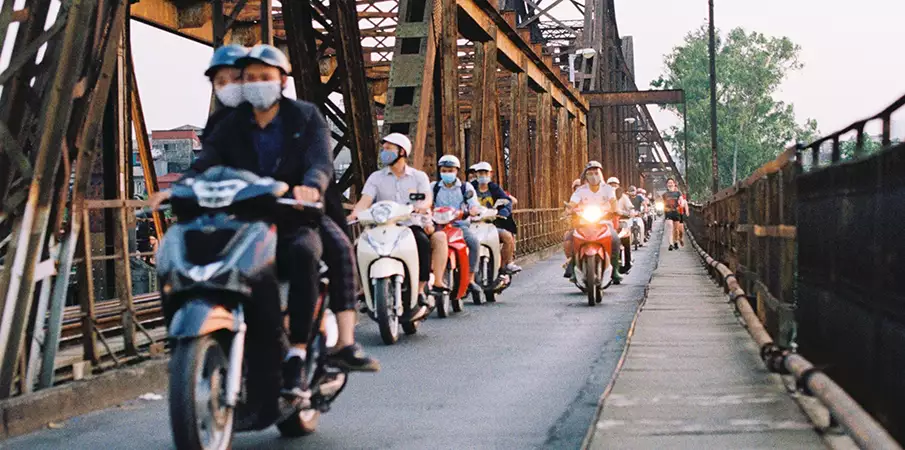
History of Long Bien Bridge in Hanoi:
-
- The Long Bien Bridge was originally built by French architects and engineers in 1903 during the French colonial period in Vietnam. It was designed by Gustave Eiffel, the renowned French architect who also designed the Eiffel Tower in Paris.
-
- The bridge was built to connect Hanoi with the port city of Hai Phong, which was an important trading hub for French Indochina. At the time of its construction, it was the longest bridge in Southeast Asia, measuring over 1.5 kilometers in length. It was also one of the first bridges to be built across the Red River.
-
- During the Vietnam War, the bridge became a strategic target for the United States military, and it was heavily bombed. However, the bridge survived the bombings and was repaired and reopened in 1973 after the war ended. Today, it stands as a testament to Vietnam’s rich history and resilience.
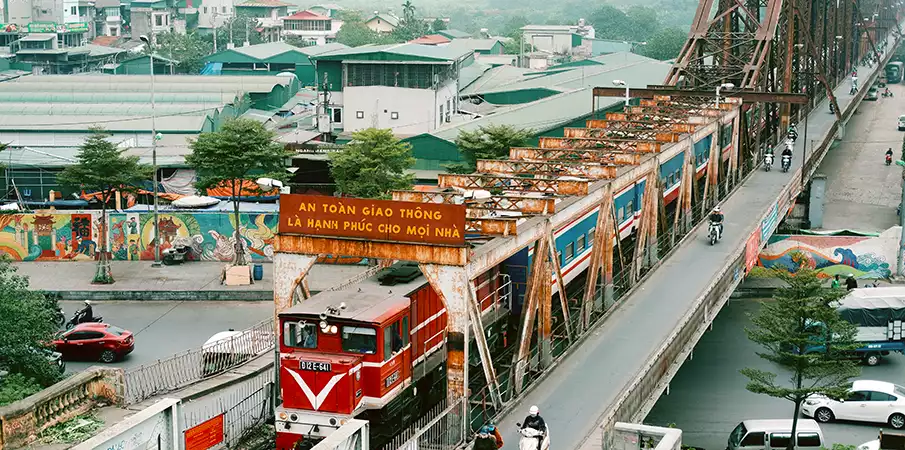
What to See at Long Bien Bridge:
-
- Long Bien Bridge is a popular attraction for tourists who visit Hanoi. One of the best ways to experience the bridge is to take a walk across it. The bridge provides a unique perspective on the city, and the views of the Red River are breathtaking.
- Visitors can also take a train across the bridge, which is a fun and exciting way to experience the bridge’s engineering marvel. The train runs regularly, and it offers an excellent opportunity to take pictures and admire the bridge’s architecture.
- Another interesting thing to see at the Long Bien Bridge is the daily market that takes place underneath the bridge. The market is a bustling hub of activity, and it offers a unique shopping experience for visitors. The market is especially vibrant in the early morning hours when vendors set up their stalls and start selling fresh produce, meat, and other goods.
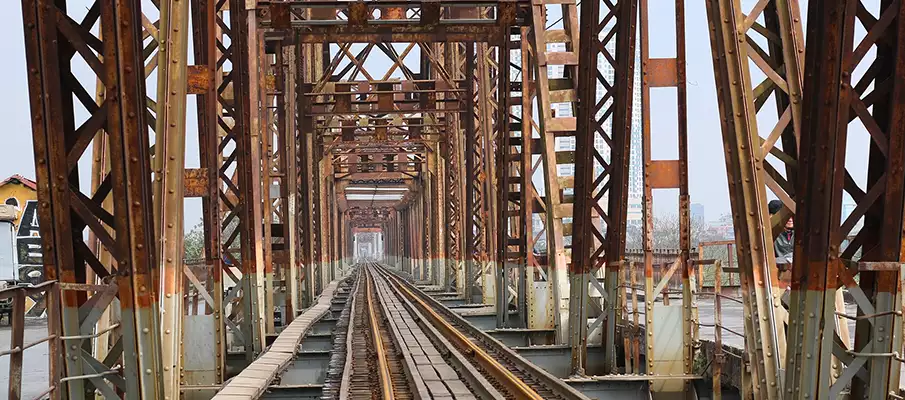
How to move on Long Bien Bridge in Hanoi:
There are a few ways to move around and explore the Long Bien Bridge in Hanoi – Hoan Kiem:
-
- 1. Walking: One of the best ways to experience the bridge is by walking across it. The pedestrian walkway is located on the side of the bridge and offers stunning views of the Red River and the city skyline. Walking across the bridge takes around 20-30 minutes, depending on your pace, and is a great way to take in the bridge’s unique architecture. Long Bien Bridge is about 1 km from Hoan Kiem Lake, close to Old Quarter of Hanoi.
- 2. Biking: For those who prefer a more active way of exploring, biking across the bridge is another option. Bikes can be rented from various shops in Hanoi and can be brought onto the bridge. Biking across the bridge allows you to cover more ground and explore the surrounding areas on either side of the river.
- 3. Train: The Long Bien Bridge is still used by trains, and a train ride across the bridge is a unique and exciting experience. The train passes slowly over the bridge, offering passengers a chance to take in the views and snap some photos.
- 4. Motorbike or car: For those who prefer to explore at their own pace, driving across the bridge in a motorbike or car is also an option. However, it’s important to note that traffic on the bridge can be heavy, so it’s best to exercise caution and follow traffic rules.
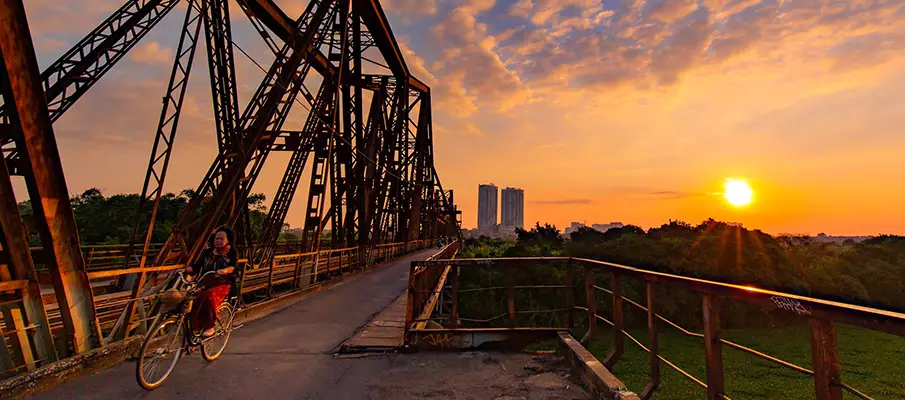
Interesting Facts About Long Bien Bridge:
-
- The Long Bien Bridge is one of the oldest bridges in Hanoi and has become an important cultural symbol of the city.
- During the Vietnam War, the bridge was a key target for bombing by the United States military. Despite being heavily damaged, the bridge remained standing and was repaired after the war.
- The bridge has been featured in several movies and TV shows, including the film „Indochine“ and the TV series „The Amazing Race Asia.“
- The Long Bien Bridge was once known as the „Paul Doumer Bridge,“ named after the Governor-General of French Indochina. However, after Vietnam gained independence in 1954, the name was changed to Long Bien.
- The bridge is used by trains, motorbikes, bicycles, and pedestrians, making it a bustling hub of activity in the heart of Hanoi.
- The Long Bien Bridge has undergone several renovations over the years, including a recent restoration project that began in 2018.
- The bridge has become a popular spot for photographers, who come to capture its unique architecture and stunning views of the Red River and the city.
- The market underneath the bridge is a popular spot for locals and tourists alike to buy fresh produce, souvenirs, and other goods.
- In 2012, the Long Bien Bridge was recognized as a National Heritage Site by the Vietnamese government, further solidifying its importance as a cultural landmark in Hanoi.
- Gustave Eiffel, the architect who designed the Eiffel Tower in Paris, also played a role in the design of the Long Bien Bridge. While he didn’t oversee the construction, his company supplied the steel used in the bridge’s construction.
📍 Location of Long Bien Bridge in Hanoi
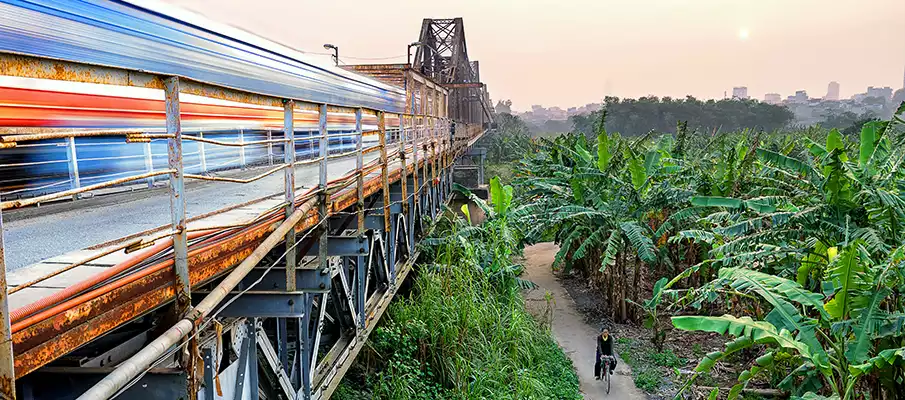
❓ FAQ + TIPS for visitors of Long Bien Bridge:
1. What is Long Bien Bridge?
-
- Long Bien Bridge is a historic bridge that spans the Red River in Hanoi, Vietnam. It was built in 1903 during French colonial rule and is one of the most iconic landmarks in the city.
2. How long is Long Bien Bridge?
-
- The Long Bien Bridge in Hanoi is approximately 1.68 kilometers (1.04 miles) long.
3. Can visitors walk across Long Bien Bridge?
-
- Yes, visitors can walk across the bridge on the pedestrian walkway. However, it’s important to be cautious as the bridge is still used by trains and motorbikes.
4. What is the best time to visit Long Bien Bridge?
-
- The best time to visit is during the early morning or late afternoon when the light is softer and the weather is cooler. Sunset is also a popular time to visit as it offers stunning views of the city. Read this article: Weather in Hanoi.
5. What is the history of Long Bien Bridge?
-
- Long Bien Bridge was built during the French colonial period to connect Hanoi with the nearby port city of Hai Phong. It played an important role in the transportation of goods and people throughout the region.
6. Is Long Bien Bridge still in use?
-
- Yes, the bridge is still in use today and serves as an important transportation link for both trains and motorbikes. However, there are plans to build a new bridge to relieve some of the traffic congestion.
7. What is the architecture of Long Bien Bridge?
-
- The bridge features a unique combination of French and Vietnamese architectural styles. It has a lattice-like steel structure and features stone pillars and arched spans.
8. What are some interesting facts about Long Bien Bridge?
-
- Long Bien Bridge is the oldest bridge in Hanoi and was once the longest bridge in Southeast Asia. It has survived numerous wars and conflicts, including the Vietnam War, and is a testament to the resilience of the Vietnamese people.
9. Are there any restrictions for visiting Long Bien Bridge?
-
- Visitors are not allowed to climb on the bridge or take photographs from the railway tracks. It’s important to be respectful of the people who live and work in the area around the bridge.
10. What else is there to see near Long Bien Bridge?
-
- There are several other interesting attractions in the area around Long Bien Bridge, including the Dong Xuan Market, the Hanoi Citadel, and the Quan Thanh Temple. Visitors can also take a boat tour of the Red River to see the bridge from a different perspective.
11. How to travel solo in Vietnam?
-
- Discover the wonders of solo travel in Vietnam as you explore ancient temples, cruise through scenic landscapes or karst sceneries, hike various national parks and ethnic villages and connect with the warm-hearted locals, creating a personalized journey of cultural immersion and breathtaking experiences.
12. What are the most interesting things or facts about Vietnam?
-
- Vietnam, a country with a captivating allure, is celebrated for its breathtaking landscapes, including the mesmerizing limestone karsts of Halong Bay, the terraced rice fields of Sapa, and the bustling waterways of the Mekong Delta. Its rich history unfolds through ancient temples in Hanoi, the imperial city of Hue, and the Cu Chi Tunnels, providing a glimpse into Vietnam’s resilience during wartime. The country’s vibrant culture, delicious cuisine, and warm hospitality further enhance the allure of this Southeast Asian gem. Read this: 15 Interesting Things of Vietnam.
13. What to expect from Vietnam Culture?
-
- Expect a vibrant cultural tapestry in Vietnam, characterized by traditional values, a strong sense of community, and a deep-rooted respect for family. You’ll encounter a fusion of French, Chinese, and indigenous influences in art, architecture, and cuisine. Traditional water puppetry, folk music, and dance performances showcase the country’s artistic flair. The importance of rituals and festivals in daily life adds a colorful dimension, while the warmth and friendliness of the Vietnamese people make for a welcoming and enriching cultural experience.
BOOK a TOUR / ACTIVITY in Hanoi ➜
| Long Bien Bridge: A Historical Marvel of Hanoi | Description |
|---|---|
| 1. Colonial Legacy: |
Long Bien Bridge, a remarkable feat of engineering, is a living relic of Vietnam’s colonial history. Originally constructed during French colonial rule, it was named after Paul Doumer, who served as the Governor-General of French Indochina. This bridge, completed in 1902, remains a poignant reminder of a bygone era. |
| 2. Iconic Red-Orange Hue: |
A defining characteristic of Long Bien Bridge is its vibrant red-orange color. This distinctive hue has become a symbol of the bridge, and it stands out prominently against the backdrop of Hanoi’s urban landscape. The bridge’s color has a rich historical significance, signifying strength and endurance. |
| 3. Over a Century Old: |
Long Bien Bridge has gracefully endured the test of time, celebrating over a century of existence. Constructed in 1902, it has seen the rise and fall of empires, the turmoil of wars, and the birth of a nation. The bridge has not only withstood the forces of nature but also the weight of history. |
| 4. Architectural Splendor: |
The bridge’s architectural design is a striking blend of form and function. The intricate metalwork, graceful arches, and decorative details make it an exquisite example of classical French architecture. The fusion of aesthetics and practicality is a testament to the craftsmanship of the era. |
| 5. Historical Symbolism: |
Long Bien Bridge holds profound historical symbolism. During the Vietnam War, it played a vital role as a transportation route for the city of Hanoi, linking it to the port city of Haiphong. This strategic importance made the bridge a prime target for bombings, and its endurance amid the conflict became a symbol of resilience and recovery. |
| 6. Changing Names: |
The bridge has undergone multiple name changes, each reflecting the political shifts in Vietnam’s history. Following the country’s independence, it was renamed Long Bien Bridge, paying tribute to the courageous efforts of Vietnamese soldiers during the war. The evolving names tell a captivating story of Vietnam’s path to independence. |
| 7. Double-Decker Design: |
Long Bien Bridge boasts a unique double-decker design, a pioneering concept of its time. The upper level initially accommodated trains, while the lower level served as a passage for road traffic and pedestrians. This innovative design was ahead of its era and significantly contributed to the bridge’s historical significance. |
| 8. Restoration and Preservation: |
In recent years, extensive restoration and preservation efforts have been undertaken to ensure the bridge’s structural integrity and historical value are maintained. A dedicated team of experts and craftsmen have meticulously worked to safeguard the bridge’s architectural charm, allowing it to continue captivating future generations. |
| 9. A Symbol of Resilience: |
Long Bien Bridge embodies the indomitable spirit of the Vietnamese people. It stands as a testament to their unwavering resolve in the face of adversity. Despite enduring war and tumultuous times, the bridge has remained steadfast, symbolizing the nation’s resilience, strength, and determination to overcome challenges. |
| 10. Cultural Landmark: |
Long Bien Bridge transcends its physical form to become a cultural landmark. It has been a source of inspiration for countless artists, writers, and photographers. The bridge’s aesthetic and historical significance have made it a cherished part of Vietnam’s heritage, reflected in numerous artistic expressions and literary works. |
Bach Long Glass Bridge|Can Tho – Travel Guide|Hue – Travel Guide|Nha Trang – Travel Guide|Hoi An – Travel Guide|Con Dao – Travel Guide



